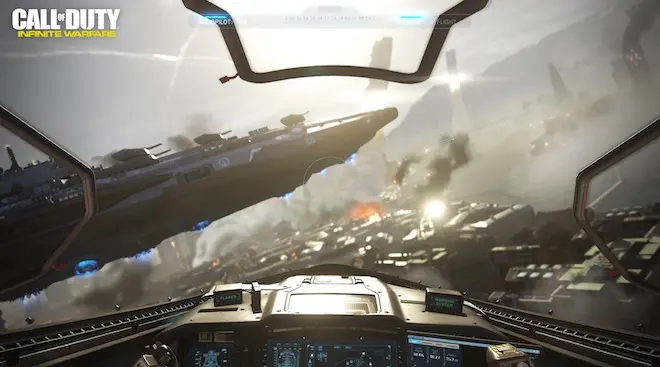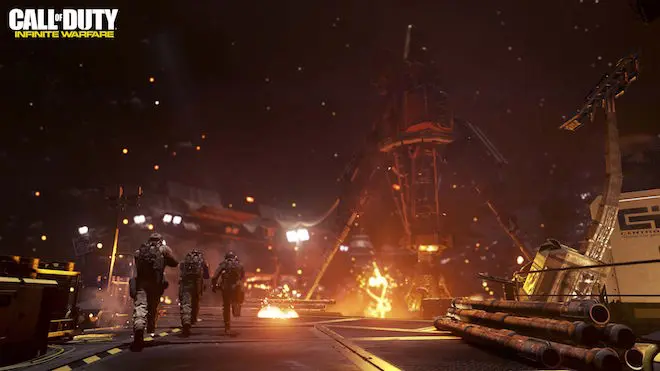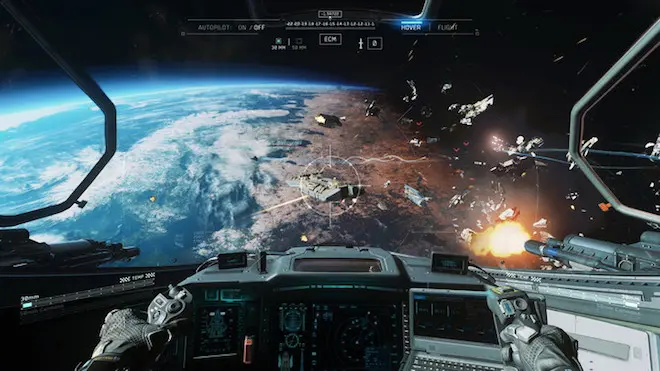When I say that Call of Duty: Infinite Warfare is all about star wars, I mean it as in wars being fought in the stars, and not the silly little space opera that George Lucas created. For the first time in the series’ long history, Call of Duty has taken the fight far into the future, where space travel and planetary colonization are common things, and Earth is one unified government and not fractured by continent and country. In a game that is closer to Battlefront than it is Battlefield, Infinity Ward and Raven and Activision have taken a huge chance on space being the final frontier, and the gamble seems to have paid off for the most part.
Call of Duty: Infinite Warfare follows the recent trend of shipping with three distinct game modes: a bombastic, cinematic story/campaign, multiplayer, and horde-survival zombies. The fact that the zombies mode has now been given the same love as the other two modes shows Activision and its team of developers are looking to shake things up in the franchise. But it’s not just the rise of zombies mode that pushes the envelope here. The campaign itself brings in many new changes, and all of them are worth it.
The story in Call of Duty: Infinite Warfare centers around a revolt of miners and colonists on Mars, led by Salen Kotch (Kit Harington, from TV’s Game of Thrones). This group calls themselves the Settlement Defense Front, or SetDef, or just The Front, and they hate Earth, and they make that hate known during the UNSA’s Fleet Week celebration in Geneva, when a concentrated attack essentially destroys the fleet, save for one ship: the Retribution. The player takes control of Captain Nick Reyes, who is thrust into the war by trying to beat back the invading SetDef forces, and then take control of the Retribution to hunt down and kill Kotch and his rebellious forces. The story is epic and emotional, and has some twists and turns that makes it one of the best in the series.
Throughout the campaign, players choose their missions from the deck of the Retribution. And in addition to main story missions, there are options for two types of side missions: Jackal missions and boarding missions. For Jackal missions, players jump into the kick-ass Jackals, a fighter jet that can be used both in atmospheric and orbital combat, and engage in off-rails flying missions. This is probably my favorite part of the whole game, as aerial combat is something that Call of Duty has always lacked (other than a on-rail, point-and-shoot mission here or there).
The boarding missions task players with saving hostages, taking out HVTs (High-vaule targets), and sabotaging SetDef in one way or another. These are sneaking missions, and the new toys and gadgets designed for Call of Duty: Infinite Warfare come into play here. Things like anti-gravity grenades, which causes a bubble of anti-gravity, allowing the player to pick off the enemy as they float helplessly in the bubble. There are also drones and seeker droids that can be deployed and, of course, an entire armory of weapons. Infinite Warfare finally does away with tracking down hidden intel or other assorted baubles in levels, and instead has replaced it by scanning new weapons on the go. This is also a welcome change.
These side missions unlock new upgrades across the board, whether its a Jackal enhancement like better guns, armor, or seeker missiles, or character upgrades, which come in the form of perks. This makes the missions well worth completing and add so much more to the game.
The biggest change in the Call of Duty: Infinite Warfare campaign mode is that the entire story is seamless. As in there are literally no loading screens. Missions bleed into each other, and basically, the story is told in one very, very long day. I was about halfway through the campaign before I realized that I hadn’t seen a loading screen, and according to the mission select menu option, I had completed just over half of the story missions, and it felt very fluid and natural, and I really enjoyed the change.
The multiplayer mode in Call of Duty: Infinite Warfare adds a few new cosmetic features, like designated mission teams (think clans) where like-minded players across the world can play for one designated team. These mission teams have objectives that players can complete in matches for rewards and XP.
Combat rigs, which were introduced last year in Black Ops III as “Specialists,” return here, with six different rigs to choose from. Each rig has special weapons and perks, so players can find a rig that suits their play style. The rigs are also fully customizable as play progresses.
The maps in multiplayer are chaotic and well-designed, taking advantage of the science-fiction themes in new and unique ways. One map takes place on the moon, and once a player is killed, they lose gravity. It’s interesting to see a hallway full of floating bodies after a well-timed grenade toss, or scorestreak cash-in.
While the multiplayer doesn’t feel like there’s enough new here in Call of Duty: Infinite Warfare, it does a solid job of carrying the baton until the next big innovation. Infinity Ward knows how to maximize multiplayer by creating great maps that are fun to play, and with multiple game modes that are now separated by classic, competitive, hardcore, and feature, players can find a similarly-skilled group and have hours of fun without getting trounced by many competitive players who Prestige in less than a day and treat Call of Duty like their own personal school yard.
The zombies mode in Call of Duty: Infinite Warfare is quite possibly the best zombies game yet, and that says a lot after last year’s wonderful edition. Zombies in Spaceland continues the horde mode favorite, but this time drops players into a 1980’s amusement park. The wrap-around story focuses on a schlock horror director, Willard Wyler (voiced by Paul Reubens), who brings together four actors and then uses black magic to transport them into a B-movie, fighting for survival against zombies as they have to work together to restore power to the park. The actors are voiced by Ike Barinholtz, Seth Green, Jay Pharoah, and Sasheer Zamata, and each represents an ’80s archetype (jock, nerd, hip hop enthusiast, and valley girl, respectively). The cast is solid, and Zamata absolutely nails her character — and she is my favorite to play as. The amusement park is huge and holds many secrets, and after weeks of playing, I’m still finding cool things like easter eggs, and nods to the neon decade. And the music — the music is all 1980s, and the park DJ is none other than David Hasselhoff. It is perfect.
Aesthetically, Call of Duty: Infinite Warfare looks fantastic on the new PS4 Pro (we did not play this on a Xbox One S), as the HDR upgrades and near-4K presentation really pops the whole game off the screen, especially in Zombies mode. This might be one of the best looking COD games, and will be the first in a new graphical level of excellence that Activision and their developers can strive for going forward.
Call of Duty: Infinite Warfare makes some very long strides in the story campaign, especially by integrating more flying missions (off-rail), and the seamless presentation is solid. The multiplayer lacks in many areas and just doesn’t feel any different than any of the last few “futuristic” COD games. I would have loved to see multiplayer Jackal missions, and even in-orbit gunfight maps. You know, something to shake up the stagnant game mode. Zombies in Spaceland may be the true selling point here, as it is the strongest zombies mode to date and when coupled with the campaign, keep Call of Duty: Infinite Warfare relevant, even though there are better shooters out there this holiday season.
Call of Duty: Infinite Warfare is a solid sci-fi shooter that marries past and future, and by taking the battle to space, has tried to create a new COD experience. And it succeeds for the most part. There is still room to grow, and the developers here have proven that the mold can be broken. But for Call of Duty to remain relevant in the gaming world, that mold has to be shattered, and this game doesn’t do that. Deluxe versions of the game comes with Call of Duty: Modern Warfare Remastered, the Infinity Ward masterpiece, and that decision might not have been the best one, as playing through MW just highlights how far Call of Duty has fallen from of a true military shooting game. Maybe if the developers of newer COD games would go back and see what makes the series iconic, they can find the key to creating the perfect Call of Duty game. Call of Duty: Infinite Warfare is not perfect, but the path is there to make even longer strides to regain their place at the top of the FPS food chain.
Call of Duty: Infinite Warfare is available now for the PS4 and Xbox One. This review is based off a copy provided by Activision.











